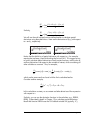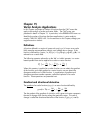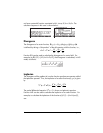
Page 14-7
Applications of function HESS are easier to visualize in the RPN mode.
Consider as an example the function φ(X,Y,Z) = X
2
+ XY + XZ, we’ll apply
function HESS to function φ in the following example. The screen shots show the
RPN stack before and after applying function HESS.
When applied to a function of two variables, the gradient in level 2, when
made equal to zero, represents the equations for critical points, i.e., ∂φ/∂x
i
= 0,
while the matrix in level 3 represent second derivatives. Thus, the results from
the HESS function can be used to analyze extrema in functions of two variables.
For example, for the function f(X,Y) = X
3
-3X-Y
2
+5, proceed as follows in RPN
mode:
‘X^3-3*X-Y^2+5’ ` [‘X’,’Y’] ` Enter function and variables
HESS Apply function HESS
SOLVE Find critical points
μ Decompose vector
‘s1’ K ‘s2’ K Store critical points
The variables s1 and s2, at this point, contain the vectors [‘X=-1’,’Y=0] and
[‘X=1’,’Y=0], respect
‘H’ K Store Hessian matrix
J @@@H@@@ @@s1@@ SUBST ‚ï Substitute s1 into H
The resulting matrix A has a
11
elements a
11
= ∂
2
φ/∂X
2
= -6., a
22
= ∂
2
φ/∂X
2
=
-2., and a
12
= a
21
= ∂
2
φ/∂X∂Y = 0. The discriminant, for this critical point
s1(-1,0) is Δ = (∂
2
f/∂x
2
)⋅ (∂
2
f/∂y
2
)-[∂
2
f/∂x∂y]
2
= (-6.)(-2.) = 12.0 > 0. Since
∂
2
φ/∂X
2
<0, point s1 represents a relative maximum.
Next, we substitute the second point, s2, into H:
J @@@H@@@ @@s2@@ SUBST ‚ï Substitute s2 into H


















